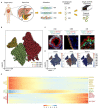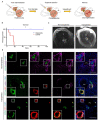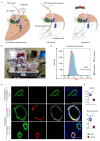Cholangiocyte organoids can repair bile ducts after transplantation in the human liver
- PMID: 33602855
- PMCID: PMC7610478
- DOI: 10.1126/science.aaz6964
Cholangiocyte organoids can repair bile ducts after transplantation in the human liver
Abstract
Organoid technology holds great promise for regenerative medicine but has not yet been applied to humans. We address this challenge using cholangiocyte organoids in the context of cholangiopathies, which represent a key reason for liver transplantation. Using single-cell RNA sequencing, we show that primary human cholangiocytes display transcriptional diversity that is lost in organoid culture. However, cholangiocyte organoids remain plastic and resume their in vivo signatures when transplanted back in the biliary tree. We then utilize a model of cell engraftment in human livers undergoing ex vivo normothermic perfusion to demonstrate that this property allows extrahepatic organoids to repair human intrahepatic ducts after transplantation. Our results provide proof of principle that cholangiocyte organoids can be used to repair human biliary epithelium.
Copyright © 2020 The Authors, some rights reserved; exclusive licensee American Association for the Advancement of Science. No claim to original U.S. Government Works.
Conflict of interest statement
Figures




Comment in
-
Emerging cell therapy for biliary diseases.Science. 2021 Feb 19;371(6531):786-787. doi: 10.1126/science.abg3179. Science. 2021. PMID: 33602846 Free PMC article. No abstract available.
-
Applications of organoids in regenerative medicine: a proof-of-concept for biliary injury.Nat Rev Gastroenterol Hepatol. 2021 Jun;18(6):371-372. doi: 10.1038/s41575-021-00459-9. Nat Rev Gastroenterol Hepatol. 2021. PMID: 33948023 No abstract available.
-
Organoid Technology Starts to Deliver: Repairing Damaged Liver Grafts During Normothermic Machine Perfusion.Transplantation. 2021 Sep 1;105(9):1886-1887. doi: 10.1097/TP.0000000000003790. Transplantation. 2021. PMID: 34416748 No abstract available.
References
-
- Drost J, Clevers H. Translational applications of adult stem cell-derived organoids. Dev. 2017;144:968–975. - PubMed
-
- Squires RH, Ng V, Romero R, Ekong U, Hardikar W, Emre S, Mazariegos GV. Evaluation of the pediatric patient for liver transplantation: 2014 practice guideline by the American Association for the Study of Liver Diseases, American Society of Transplantation and the North American Society for Pediatric Gastroenterology, Hepatology and Nutrition. Hepatology. 2014;60:362–98. - PubMed
-
- Sampaziotis F, Justin AW, Tysoe OC, Sawiak S, Godfrey EM, Upponi SS, Gieseck RL, De Brito MC, Berntsen NL, Gómez-Vázquez MJ, Ortmann D, et al. Reconstruction of the mouse extrahepatic biliary tree using primary human extrahepatic cholangiocyte organoids. Nat Med. 2017;23:954–963. - PubMed
-
- Parikh K, Antanaviciute A, Fawkner-Corbett D, Jagielowicz M, Aulicino A, Lagerholm C, Davis S, Kinchen J, Chen HH, Alham NK, Ashley N, et al. Colonic epithelial cell diversity in health and inflammatory bowel disease. Nature. 2019;567:49–55. - PubMed
Publication types
MeSH terms
Grants and funding
- MC_PC_17230/MRC_/Medical Research Council/United Kingdom
- NC/N001540/1/NC3RS_/National Centre for the Replacement, Refinement and Reduction of Animals in Research/United Kingdom
- PG/17/24/32886/BHF_/British Heart Foundation/United Kingdom
- MC_UU_12012/5/MRC_/Medical Research Council/United Kingdom
- NC/T2T0419/NC3RS_/National Centre for the Replacement, Refinement and Reduction of Animals in Research/United Kingdom
LinkOut - more resources
Full Text Sources
Other Literature Sources
Medical
Molecular Biology Databases

